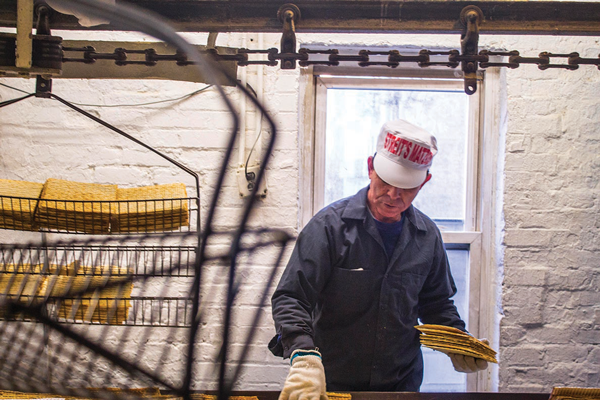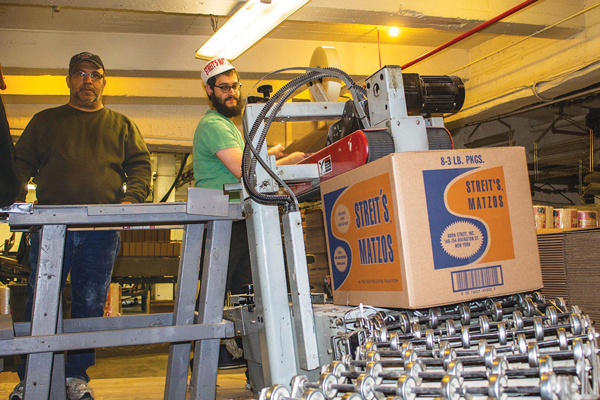
BY ZACH WILLIAMS | The Streit’s matzo company will vacate its longtime Lower East Side factory and relocate later this year.
For nine decades the family-owned company has manufactured matzo from four adjacent former tenement buildings at 148-154 Rivington St., growing over that time from a local to international brand. But just as company founder Aron Streit moved the business there in 1925 from a smaller operation on Pitt St., the time has come to secure a more modern space for the manufacture and distribution of the unleavened, pockmarked bread eaten at Passover.
“We’re basically at the same crossroads now,” said Aaron Gross, a great great-grandson of Streit who works at the company. “Manufacturing for national distribution on the Lower East Side of Manhattan is not an easy thing to do. We’re good at it. I think we do it as well as anyone could.”
A critical factor in the decision to move is the factory’s aging equipment, Gross said. The two 72-foot-long ovens are more than 70 years old and repairing them is simply not economical anymore, according to Gross. New ovens are typically 150 to 200 feet long, an obvious challenge in a factory that’s only 100 feet from front to back.
The machines that form flour and water into sheets of dough before baking, known as sheeters, also present spatial challenges, Gross said.
“Our sheeters are about 12 feet,” he explained. “You can’t get a new sheeter that’s under 30 feet long.”
A decision on where the company will next set up shop will be announced this year around Passover, Gross said. He declined to give further details or divulge to which real estate developer the current site has been sold.
Streit’s matzo production, which now comprises about 40 percent of the U.S. market, will continue without interruption, he added.
Consolidating operations into one new location will allow for some obvious efficiencies to be added into the production process. The current facility has no loading dock, leaving the shipments prone to delays on busy neighborhood streets. A move would also eliminate the need to bag matzo mix only for the trip to the company’s warehouse in New Jersey. In one facility, a single person with a hand truck could accomplish that task, Gross said.
The current factory has six floors among the four buildings, necessitating the employment of six rabbis in order to ensure products adhere to religious strictures. Two or three rabbis could handle that task in a single-story building, he added.
“I want to make this move and go from making matzo the most inefficient way to making it the most efficient way,” he said.
Certain characteristics of a Streit’s matzo derive from the factory’s sometimes-zany setup. The archaic ovens utilize convection rather than direct flames to bake matzo, said Gross, who credited this method with producing the brownish blistering on their product, as well as an even complexion on both sides. The squares of unleavened bread then travel in package-sized portions via a basket system, carrying them from floor to floor. As they do this, they cool off, giving them a freshness absent from matzo from other companies that use refrigerators, Gross said.

Staircases and corridors appear through walls and ceilings in the same places where Aron Streit wanted them way back when. Not a lot has changed since the last relocation in how they make matzo.
“When we started looking to design a new factory, the equipment manufacturers came through and were amazed that the old stuff still works and that the place was so well-designed, especially the basket system,” said Alan Adler, the company’s chief operating officer and great-grandson of Aron Streit.
Gross added that certain elements of the current production process, such as paper packaging and the basket system, might continue in a new factory.
The move will also involve a human cost, with some longtime employees unable to continue working for the company once it leaves the Lower East Side. An upcoming documentary film, “Streit’s: Matzo and the American Dream,” will portray the company, its employees and the surrounding neighborhood.
One of the last bastions of manufacturing in the neighborhood, Streit’s got its start at a time when the Lower East Side was filled with Jewish immigrants. Such a readily available customer base made Rivington St. a convenient site for business back then.
But international competition, particularly from Israel, now threatens Streit’s market share. Deep-pocketed investors now control Manischewitz and two other former domestic competitors, making Streit’s the last of four original family-owned matzo producers in the U.S.
Ten years ago, Adler told The Villager that the company retained hopes of remaining in the neighborhood for the long term.
Emotions will take over the day when the Rivington St. factory closes, but the greater tradition of maintaining a family business will remain in place as the company finally undergoes the inevitable, said Gross.
“To hang on here just for the sake of hanging on doesn’t make sense,” he said.

















